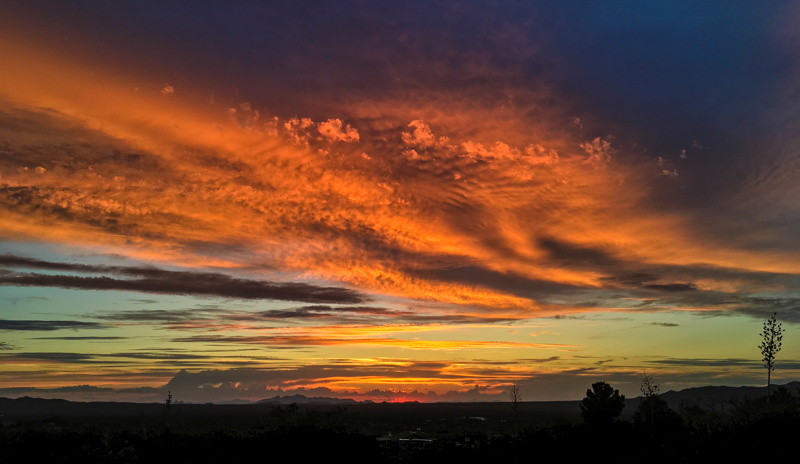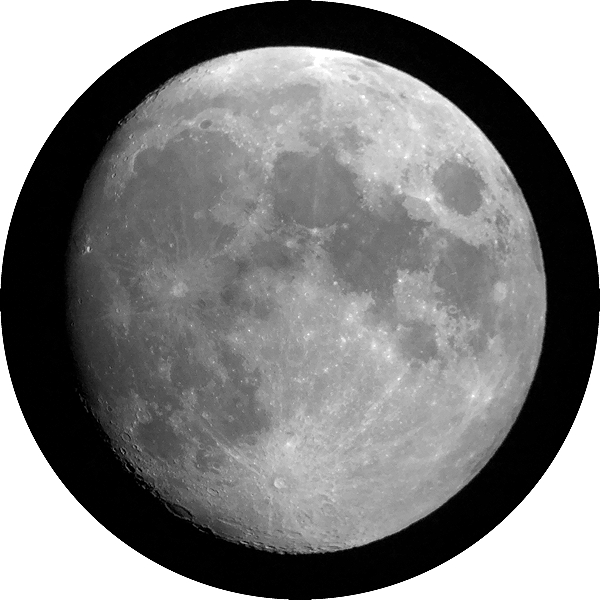Weather Updates, Waxing Gibbous Moon,
IDA Fundraising
Posted: 13 August 2019
After the big thunderstorm (0.98" rain) Wednesday afternoon, 31 July 2019, there was a nice Monsoon Season sunset:

Saturday, 3 August, Cassiopeia Observatory was visited by a couple from the Phoenix area. They wanted to see a SkyShed POD upclose.
Had a nice brief thunderstorm (0.2" rain) about sunset on Monday, 5 August, with lots of lightning:
 |
 |
 |
 |
 |
 |
 |
 |
Had another brief thunderstorm (0.16" rain) Wednesday afternoon, 7 August. And another nice sunset, Friday, 9 August:

Had a stronger thunderstorm Saturday afternoon (0.28"), 9 August, and another one early Sunday morning (0.23"), 10 August.
Cloudy skies continued until Monday, 12 August. The forecasts said the sky would be totally clear all day and night, but lots of cumulus clouds appeared mid-day and continued through sunset. Decided to open the observatory anyway.
|
Open: Monday, 12 August 2019, 1857 MST Temperature: 95°F |
Session: 1371 Conditions: Partly clear |
Equipment Used:
12" f/8 LX600 w/StarLock
2" 24mm UWA eyepiece
1.25" 15mm eyepiece
2" 30mm eyepiece
Camera:
D850 DSLR
iPhone 8 Plus
SYNCed observatory clock to WWV time signals.
1910 MST: LX600 ON, StarLock OFF, High Precision OFF.
1912 MST: viewed Jupiter, 102X. The four Galilean Moons were visible. The moon Io was visible just off the planet's disk as its transit had ended at 1905 MST.
1916 MST: sunset.
1918 MST: viewed Jupiter, 163X. Io's shadow was still in transit and visible near the planet's central meridian. Seeing was not very good however.
1925 MST: viewed Saturn, 163X. Seeing not good.
Took this handheld photo of the waxing gibbous Moon with the D850 DSLR (f/6.3, 1/1250sec, ISO 500, FL 600mm). Saturation was increased to show the colors on the Moon.

1934 MST: viewed Saturn, 163X. Its moon Titan was visible.
1936 MST: viewed the Moon, 102X and 81X. Took this handheld iPhone 8 Plus photo of the Moon, afocal 81X, using the iOS app NightCap Camera (ISO 22, 1/2500sec).

Then began some lunar observing, 163X. The crater Aristarchus and the Vallis Schröten were nice. Took this handheld iPhone photo of Aristarchus and the Vallis Schröten, afocal 163X, NightCap Camera (ISO 22, 1/1000sec).

1958 MST: viewed Saturn again, 163X. Three moons were now visible. Then viewed Jupiter, 163X. Io's shadow was now near the planet's limb. Seeing was still not good.
Seeing was not good enough this session to do more tests of the Atmospheric Dispersion Corrector (ADC). Hopefully, I'll be able to use the ADC on the next session. But it was nice to be back in the observatory after the long period of cloudy nights.
2006 MST: LX600 OFF.
|
Close: Monday, 12 August 2019, 2016 MST Temperature: 84°F |
Session Length: 1h 19m Conditions: Clear |
The returned PZT table has already begun deteriorating in less than one month. Photos here.
On Thursday, 1 August 2019, it was announced that Oracle, Arizona, will be pursuing the IDA "International Dark Sky Community" designation to go along with Oracle State Park being designated as an IDA "International Dark Sky Park" (in 2014). The Oracle Dark Skies Committee is being reformed to work on the designation. Although I will be helping the Committee, I won't be chairing it this time.
And speaking of the International Dark-Sky Association (IDA), the "Protect the Night" Matching Gifts Challenge fundraiser has been extended until 15 August. My page has fallen to 3rd place (by quite a lot). If you can help IDA and help return my page back to 1st place, please go to the IDA "Protect the Night" page, click my name, and then click on the Donate button. Every gift is doubled. Many thanks. Here are the top four donation pages as of 12 August:
Comments are welcome using Email. Twitter users can use the button below to tweet this report to their followers. Thanks.
Cassiopeia Observatory Home Page
Copyright ©2019 Michael L. Weasner / mweasner@me.com
URL = http://www.weasner.com/co/Reports/2019/08/13/index.html

